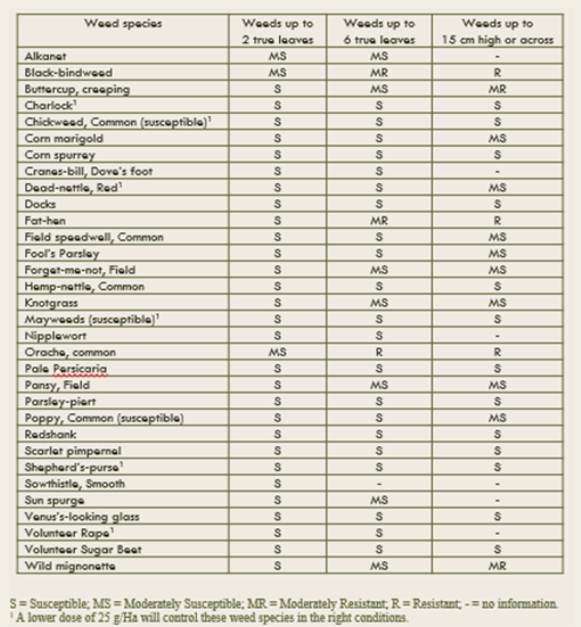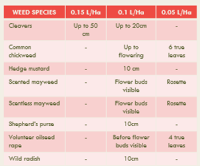Welcome to the May edition of the Life Scientific Newsletter.
The weather has finally improved for most and we are being asked how our products can help to deal with lots of crop protection issues, such as disease control with a lack of T0 sprays, and uncontrolled spring weeds in a range of crops. We cover some of those in this newsletter along with a reminder of some of our products which are currently being used in the field.
We are continuing to support and develop our existing and future range and this year we have more field trials than ever before to investigate how our products fit in constantly changing weed, pest and disease programmes. This month we’ll look at one of those trials showing the equivalence of our product against the original R&D manufacturer.
Cereal fungicides
Once again, the weather has made choice of T1 and T2 products challenging, with a lack of T0 sprays being applied in some areas. Whilst new chemistry provides opportunities for effective control of key diseases, it needs supporting with alternative modes of action to prevent resistance developing, and to help achieve the broad-spectrum disease control needed.
ESKER, containing tebuconazole and prothioconazole, is approved in wheat, barley, oats and winter rye and can help with both of the issues mentioned. The combination of the two active ingredients makes it a reliable component of cereal fungicide programmes, with activity against a wide range of diseases including rusts, powdery mildew, eyespot, net blotch, and rhynchosporium.
See the approved product label for detailed crop use instructions.
Wild-oats
Grass weed control is especially important this spring as growers try to protect as much yield as possible following the challenging months getting the crop established.
One of the key grass weeds to control in cereals is Wild-oats, with the weed being more than twice as competitive as Black-grass. Just 1 plant/square metre can reduce yield by 1 tonne/Ha in winter cereals and 0.6 tonnes/Ha in spring cereals. Higher populations are particularly concerning this season as yield protection is key to profitability.
Wild-oats germinate mainly in the spring and it is important to control them early to avoid significant yield loss.
One useful tool in Life Scientific’s armoury is KIPOTA, an EC formulation containing 240g/L clodinafop-propargyl, it is a reverse-engineered Topik.
The product has good activity against susceptible Wild-oats. As with all weeds, the smaller and actively-growing plants are better controlled.
KIPOTA is approved in wheat, durum wheat, rye and triticale and should be applied at 0.25 l/Ha when applied alone or at the rate of 0.125 L/Ha when used in mixture with a methylated vegetable oil or a mineral oil.
Winter and spring wheat can be treated from 1 true leaf to before the flag leaf sheath extending stage (GS 11 – 41) whilst durum wheat, rye and triticale can be treated from the 1 true leaf stage up until before the second node detectable stage (GS 11-32).
The equivalence of KIPOTA and Topik has been tested on Wild-oats in the laboratory by NIAB.
Both products were applied at a rate of 0.125 L/Ha plus oil. The photo below shows susceptible Wild-oat plants 32 days after application.
NIAB concluded that there was no statistical difference between KIPOTA and Topik in the trial.
See the approved product label for detailed use instructions and restrictions.
Broad-leaved weeds in cereals
A feature of all crops this year is the amount of broad-leaved weeds which have germinated and were not controlled earlier in the season due to the weather.
ALS-inhibitor herbicides (including sulfonyl ureas) are important for many broad-leaved weed herbicide programmes in cereals. Whilst there is a choice of different sulfonyl urea active ingredients and blends available, metsulfuron-methyl (the active ingredient in LAYA) remains the best all-rounder to control a wide range of broad-leaved weeds in wheat, barley, oats and triticale in the spring. Metsulfuron-methyl is absorbed by the foliage and roots, and translocated within the weed, working best in good growing conditions.
At the full rate of 30g/Ha, the product can have activity on some relatively large weeds (see the table below) but the broadest range of weeds controlled are on populations up to 2 true leaves.

If Cleavers, Runch or Hedge mustard are present in wheat, barley and oats, then SUMIR, containing florasulam should be used. A single application will control the listed weeds up to the growth stages specified.

As ALS-inhibitors are so widely used it is important that labels are carefully checked to ensure that the chosen product can be used in tank-mix or sequence (joint application) with other ALS products used in a single cereal crop. Remember that specific named ALS products must be approved by CRD to be added to the joint application list of a product label.
We have recently added new approved joint application products to the SUMIR label.
Check the LAYA and SUMIR labels for joint applications, detailed usage instructions and restrictions.
Maize reminder
The wet mild conditions have favoured large weed flushes in maize which must be controlled to avoid yield loss. Weeds compete most with maize early, so it is important to get on top of the problem as soon as possble, ideally within the first six weeks of the crop’s growth.
BASILICO, containing mesotrione, can be a useful addition to any maize weed control programme, having activity on some of the most challenging maize weeds such as Black-nightshade, Fat-hen and Redshank when applied at the approved rate of 0.75L/Ha. It can be applied between 2 and 8 leaves of the crop.
See the approved product label for detailed use instructions and restrictions.
Sclerotinia in oilseed rape
Last month, we showed new trials results which confirmed the persistence and activity of our boscalid fungicide, BOSCLER, against sclerotinia in oilseed rape.
Sclerotia (the resting stage of the disease) germinate best when soils are moist and warm. The ascospores that are produced stick to the oilseed rape plant during the flowering period, especially when rain occurs. The spores then need humid conditions and mild temperatures to germinate, leading to plant infection.
If these conditions sound familiar, and you have a late or prolonged flowering crop, it may be appropriate to apply a fungicide such as BOSCLER to help protect the crop. BOSCLER should be applied at 0.5 kg/Ha as a protectant spray in high disease risk situations from early to full flowering (BBCH GS 63-65) and before disease symptoms are seen in the crop.
See the approved product label for detailed use instructions and restrictions.


